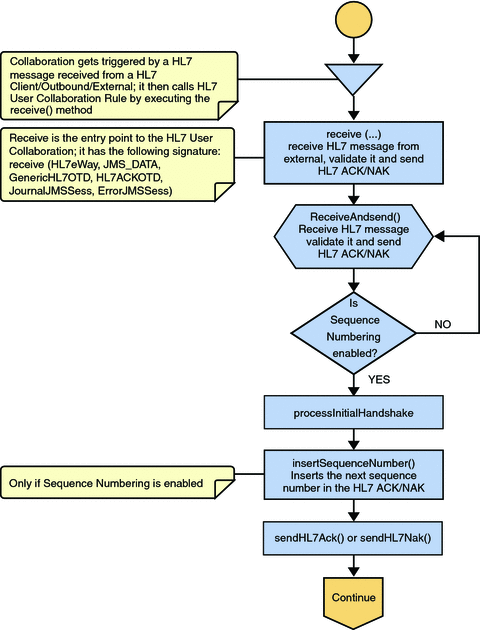Inbound HL7 V2 Collaboration - Part 1
The inbound Collaboration is triggered by an HL7 V2 message received from an external system or an outbound HL7 V2 client. The Collaboration calls the HL7 V2 user Collaboration rule by executing receive().
The receive method is the entry point to the HL7 V2 user Collaboration, with the following signature:
public void receive(com.stc.connector.appconn.tcpip.hl7.HL7ServerApplication input, com.stc.connectors.jms.JMS otdJMS_DATA, com.stc.SeeBeyond.OTD_Library.HL7.Generic.HL7_GENERIC_EVT.GENERIC_EVT otdHL7_GENERIC_EVT_1, com.stc.SeeBeyond.OTD_Library.HL7.Generic.HL7_ACK.AC K otdHL7_ACK_1,com.stc.connectors.jms.JMS otdJMS_JOURNAL, com.stc.connectors.jms.JMS otdJMS_ERROR) throws Throwable |
Note –
The above text has been wrapped to fit the page.
Once the message is received, the Collaboration determines whether the message needs to be validated. The HL7 V2 message is then validated making sure that the message structure is correct. Various fields in the MSH segment of the message are also validated, such as Version ID and Sending Facility. If these fields do not match the configuration, a NAK is returned.
If sequence numbering is enabled the Collaboration checks to see if the messages sequence number is valid. If the sequence number is not valid, the adapter sends a NAK.
The validated HL7 V2 message moves on to processInitialHandshake() and the sequence numbers are synchronized. The sequence number within the message is checked against the expected sequence number. If the numbers match, the Collaboration sends an ACK, if not it sends a NAK. The ACK or NAK includes information from various fields of the incoming MSH segment. The ACKs level of acknowledgement is set to A (acknowledgement is sent after the message is successfully processed) or C (acknowledgement is sent when the message is successfully received).
Figure 9 Inbound HL7 V2 Collaboration - Part 1

- © 2010, Oracle Corporation and/or its affiliates
